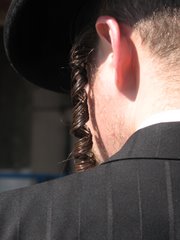On Tuesday I rode an Israeli camel for a few hours, on Wednesday I sat astride a Jordanian donkey for a few kilometers, and on Thursday my American ass hurts!
The guide for the camel ride showed us how to sit properly - with one leg hooked around the front of the camel seat, to make it harder to be dislodged - and how to command our "ships of the desert". My camel, Esther, kept testing me by stopping to eat shrubs. Eventually I got the hang of being the boss and she started to obey. Leading her down a hill by walking in front of her, the rope over my shoulder, she would stop whenever I stopped. Seeing our humpbacked friends sit down, a multistage process which ends up with them resting on their knees, reminded me of yoga's camel pose, which I usually sit out during the sequence. Unlike a camel, I don't have the joints for such a position.
I ended up atop a Jordanian donkey on the way out of Petra, a Nabatean city carved of reddish rock. After hearing so many people gush about this site in Jordan, which some call the eighth wonder of the world, I decided to book a tour. My companions were five Christian pilgrims, two from Germany and three from the US, who were doing a tour of holy places. The donkey ride was unexpected, but our guide arranged it for us to accommodate a woman in the group who was too fatigued to walk back to our vehicle.
Petra lived up to its reputation. The natural rock formations, in addition to the carvings, were stunning in their shapes and colors. It is believed that the sea once covered the area, and between the movement of the water and earthquakes this region was formed. Apparently much of what was thought to have been true about the creators and inhabitants of ancient Petra is now considered speculative at best, so I won't go into any details (Googlers, let me know what you find!).
Equally fascinating was a chance to take a peek at life in Jordan during the two hour car ride in each direction and to see how it compares with the south of Israel, with which it shares the same geography and climate. The contrast between Eilat and Aqaba, both port cities and resorts, was quite striking. Sorry, Aqaba, you lose. In Jordan, traditional desert life seems to persist despite the country's attempts to settle its Bedouin population in stationary communities. Many of these nomads do have basic homes but they continue to be close to the land. Lone figures cloaked in flowing robes herded large flocks of sheep, goats and camels in the hills en route to Petra.
In and around the town of Petra itself, a few luxury hotels have opened to capture the growing interest in this site. Despite these signs of modernity the people in this part of the country appear to be fairly traditional, with many women covered from head to toe, with only their eyes visible. One woman even had her eyes covered with a thin black veil; presumably she could see out but it was disconcerting to observe a faceless black shape moving in the street. And I wonder - seriously - if young children are frightened the first time they see their mother cover herself completely? It spooked me. Jerusalem's religous women seem risque by comparison.
At the site, which is enormous (we barely scratched the surface), the local Bedouins were trying to make a living selling donkey and camel rides, bottles filled with designs of colored sand, postcards and a surfeit of undifferentiated trinkets at prices that fluctuated depending on the gullibility of the potential customer and the savviness of the vendor. Apparently only the families and descendants of the people who had been living at Petra, before the government relocated them, are allowed to conduct business there. Sadly, even toddlers get in on the action, aggressively peddling Petra rocks for 1 Dinar (about $1.50), tailing tourists for yards until they relent (I did not, except one girl, who was probably 3, tried to relieve me of my backpack!). The older boys were darkly handsome - black hair, nearly black skin, and white teeth. Wearing traditional headcoverings (a kafiyah? I think) and languidly sitting atop their camels and horses, baking in the heat, they looked like Arabian warriors. I could just imagine them charging into the distance.
Returning to Israel, we passed through a sand storm that obliterated the horizon and sent particles of earth every which way, creating a beige fog. The weather in Eilat was exactly the same - hot, dry with dirt in the air - but nevertheless I was extremely relieved to be back home.
Thursday, May 3, 2007
Subscribe to:
Post Comments (Atom)

No comments:
Post a Comment